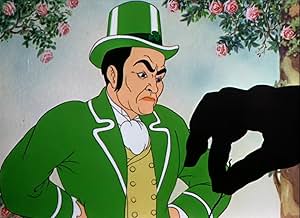Ajouter une intrigue dans votre langueOne of the prohibited Warner Bros. cartoons, short course of history, pygmies, gypsies and presidents.One of the prohibited Warner Bros. cartoons, short course of history, pygmies, gypsies and presidents.One of the prohibited Warner Bros. cartoons, short course of history, pygmies, gypsies and presidents.
- Réalisation
- Scénario
- Casting principal
Mel Blanc
- Native Chief
- (voix)
- (non crédité)
- …
Robert C. Bruce
- Narrator
- (voix)
- (non crédité)
Avis à la une
Tex Avery Merrie Melodies short about an airplane flying around the world. Basically a mock travelogue that's just a series of sight gags instead of a real plot. Avery was the master of these types of cartoons. While this isn't his best (see Avery's Tomorrow series for that), I still find it enjoyable. The most notable part of the short today would probably be the part that takes place in "Darkest Africa." Here we have some of the stereotypical portrayals of African natives that were prominent at the time in film and cartoons. It won't sit well with some today so be warned if you're easily offended. All together it's an interesting short with some really good animation and a few funny gags. The hair bit was probably my favorite because I didn't see it coming. Not among Avery's best work but solid.
This is one of the last cartoon shorts directed by Tex Avery before he left Merrie Melodies (Warner Brothers) and had a much more successful career with MGM. And considering the dubious quality of the material with "Aviation Vacation", it was a good decision! The first 2/3 of this cartoon is a very innocuous little cartoon--not particularly funny but on par with the sorts of shorts they were making before the studio really hit their stride with cartoons. It tries very hard to be a funny documentary about airplanes but most of the jokes fall pretty flat. At this point, I was very curious why the short has been shelved by Warner Brothers. However, at the five minute mark...WOW! This portion of the film was set in Africa and the natives all are the sorts of stereotypes that make folks cringe today--bones through the noses, huge lips and the like. It was embarrassing and sad...and not one bit funny. Combine that with the rest of the cartoon and I feel it is no great loss that this one was shelved. But, if you are curious, it can be downloaded for free at archive.org. Sad.
This early Tex Avery effort, made way back when he was still calling himself Fred, already features his crazy trademarks. The whole cartoon is just a collection of crazy sight gags one after another. On this plane trip to Africa (via Ireland), airplanes fly like birds, sound like trains and dance to music. Shadows move like they have a mind of their own, Mount Rushmore get a (at the time) topical joke and even the sun and moon get in on the act. Strangely enough there are no references to W.W.II.
During a musical interlude Patrick the Irish man (who looks amazingly like the young Sean Connery in "Darby O'Gill and the Little People", 1959) does the old gag with the hair on the lens. Patrick and the first African natives we see are roto-scoped, but they soon make way for some politically incorrect stereotypes. When Fred Avery directs nobody is safe: Ostriches are portrayed as the stupid birds they really are, butterfly's are used for fart jokes and on the retour trip to America the merry go round went down. Don't worry if you did not get that last one, neither did I when I saw it.
6 out of 10
During a musical interlude Patrick the Irish man (who looks amazingly like the young Sean Connery in "Darby O'Gill and the Little People", 1959) does the old gag with the hair on the lens. Patrick and the first African natives we see are roto-scoped, but they soon make way for some politically incorrect stereotypes. When Fred Avery directs nobody is safe: Ostriches are portrayed as the stupid birds they really are, butterfly's are used for fart jokes and on the retour trip to America the merry go round went down. Don't worry if you did not get that last one, neither did I when I saw it.
6 out of 10
Le saviez-vous
- AnecdotesThe Mt. Rushmore depiction involving two extra portraits, one resembling a past president of the United States, Franklin D. Roosevelt, who ran on the Democratic ticket, and his opponent during the 1940 presidential election, Wendall Wilkie, the Republican nominee.
- Versions alternativesTwo entire scenes are removed from the current version that airs on Cartoon Network. The first is a scene with an African Native, who is about to shoot a blowgun. It is revealed that he is merely aiming at a practice target. A second native comments, "Terrible shot, Joe." The other scene shows African natives pounding their drums and making signals, as the camera pans to the different villages they are communicating to. One native asks another, "Uh, what he say?" The other native says (imitating drum sound), "He say, uh, Boom di di boom di di boom boom boom boom..."
- ConnexionsFeatured in Behind the Tunes: A Conversation with Tex Avery (2004)
- Bandes originalesWhen Irish Eyes Are Smiling
(uncredited)
Music by Ernest Ball
Lyrics by George Graff and Chauncey Olcott
Sung by Bill Days as the Irish Tenor
Meilleurs choix
Connectez-vous pour évaluer et suivre la liste de favoris afin de recevoir des recommandations personnalisées
Détails
- Date de sortie
- Pays d’origine
- Langue
- Aussi connu sous le nom de
- Tour du monde en avion
- Lieux de tournage
- Société de production
- Voir plus de crédits d'entreprise sur IMDbPro
Contribuer à cette page
Suggérer une modification ou ajouter du contenu manquant

Lacune principale
By what name was Aviation Vacation (1941) officially released in Canada in English?
Répondre















